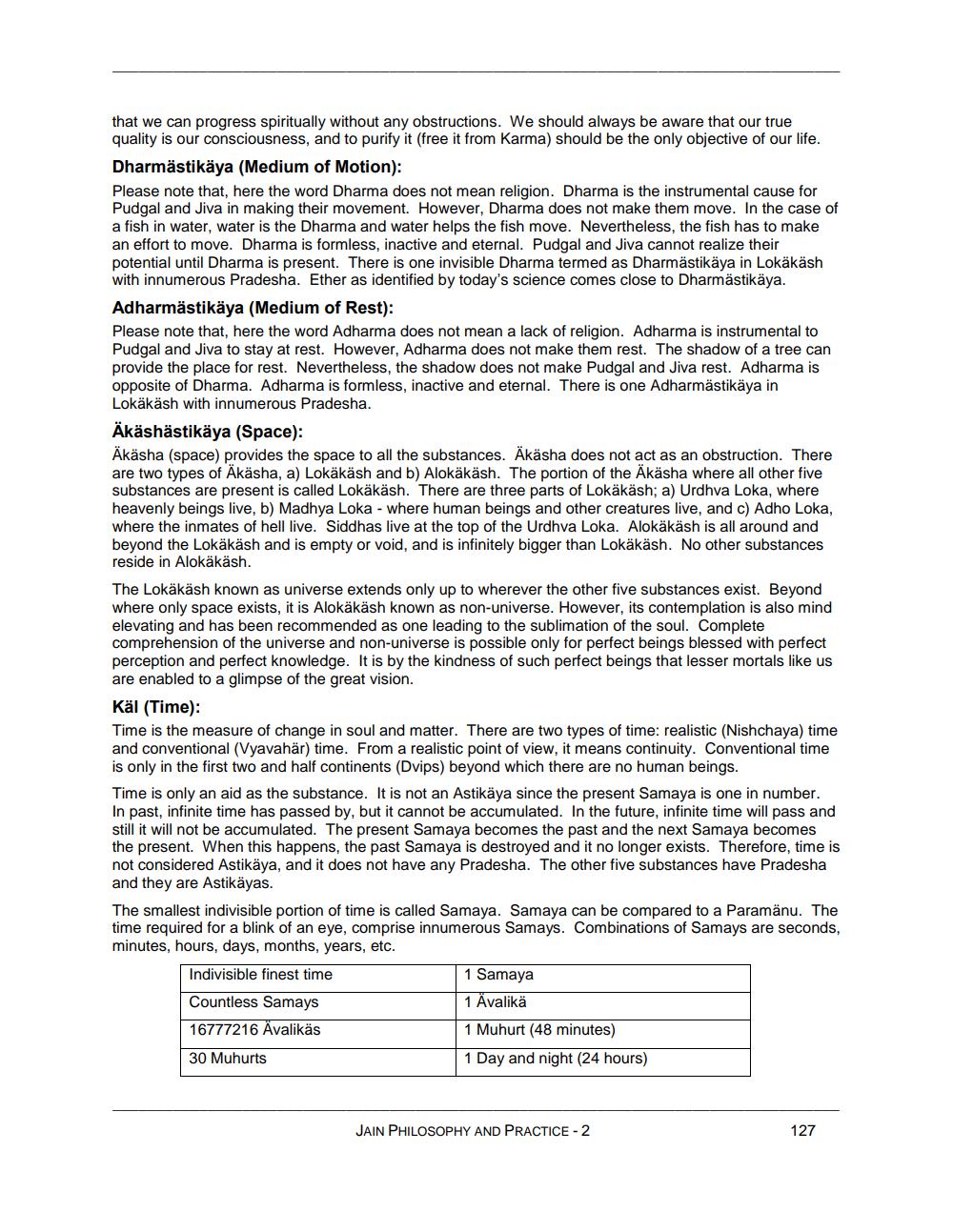________________
that we can progress spiritually without any obstructions. We should always be aware that our true quality is our consciousness, and to purify it (free it from Karma) should be the only objective of our life.
Dharmästikäya (Medium of Motion):
Please note that, here the word Dharma does not mean religion. Dharma is the instrumental cause for Pudgal and Jiva in making their movement. However, Dharma does not make them move. In the case of a fish in water, water is the Dharma and water helps the fish move. Nevertheless, the fish has to make an effort to move. Dharma is formless, inactive and eternal. Pudgal and Jiva cannot realize their potential until Dharma is present. There is one invisible Dharma termed as Dharmästikäya in Lokäkäsh with innumerous Pradesha. Ether as identified by today's science comes close to Dharmästikäya.
Adharmästikäya (Medium of Rest):
Please note that, here the word Adharma does not mean a lack of religion. Adharma is instrumental to Pudgal and Jiva to stay at rest. However, Adharma does not make them rest. The shadow of a tree can provide the place for rest. Nevertheless, the shadow does not make Pudgal and Jiva rest. Adharma is opposite of Dharma. Adharma is formless, inactive and eternal. There is one Adharmästikäya in Lokäkäsh with innumerous Pradesha.
Äkäshästikäya (Space):
Äkäsha (space) provides the space to all the substances. Äkäsha does not act as an obstruction. There are two types of Äkäsha, a) Lokäkäsh and b) Alokäkäsh. The portion of the Äkäsha where all other five substances are present is called Lokäkäsh. There are three parts of Lokäkäsh; a) Urdhva Loka, where heavenly beings live, b) Madhya Loka - where human beings and other creatures live, and c) Adho Loka, where the inmates of hell live. Siddhas live at the top of the Urdhva Loka. Alokäkäsh is all around and beyond the Lokäkäsh and is empty or void, and is infinitely bigger than Lokäkäsh. No other substances reside in Alokäkäsh.
The Lokäkäsh known as universe extends only up to wherever the other five substances exist. Beyond where only space exists, it is Alokäkäsh known as non-universe. However, its contemplation is also mind elevating and has been recommended as one leading to the sublimation of the soul. Complete comprehension of the universe and non-universe is possible only for perfect beings blessed with perfect perception and perfect knowledge. It is by the kindness of such perfect beings that lesser mortals like us are enabled to a glimpse of the great vision.
Käl (Time):
Time is the measure of change in soul and matter. There are two types of time: realistic (Nishchaya) time and conventional (Vyavahär) time. From a realistic point of view, it means continuity. Conventional time is only in the first two and half continents (Dvips) beyond which there are no human beings.
Time is only an aid as the substance. It is not an Astikäya since the present Samaya is one in number. In past, infinite time has passed by, but it cannot be accumulated. In the future, infinite time will pass and still it will not be accumulated. The present Samaya becomes the past and the next Samaya becomes the present. When this happens, the past Samaya is destroyed and it no longer exists. Therefore, time is not considered Astikäya, and it does not have any Pradesha. The other five substances have Pradesha and they are Astikäyas.
The smallest indivisible portion of time is called Samaya. Samaya can be compared to a Paramänu. The time required for a blink of an eye, comprise innumerous Samays. Combinations of Samays are seconds, minutes, hours, days, months, years, etc.
Indivisible finest time
Countless Samays 16777216 Ävalikäs 30 Muhurts
1 Samaya
1 Ävalikä
1 Muhurt (48 minutes)
1 Day and night (24 hours)
JAIN PHILOSOPHY AND PRACTICE - 2
127




